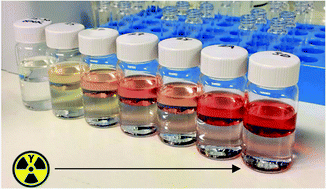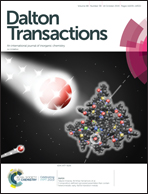Effect of chemical environment on the radiation chemistry of N,N-di-(2-ethylhexyl)butyramide (DEHBA) and plutonium retention†
Abstract
N,N-di-(2-ethylhexyl)butyramide (DEHBA) has been proposed as part of a hydro-reprocessing solvent extraction system for the co-extraction of uranium and plutonium from spent nuclear fuel, owing to its selectivity for hexavalent uranium and tetravalent plutonium. However, there is a critical lack of quantitative understanding regarding the impact of chemical environment on the radiation chemistry of DEHBA, and how this would affect process performance. Here we present a systematic investigation into the radiolytic degradation of DEHBA in a range of n-dodecane solvent system formulations, where we subject DEHBA to gamma irradiation, measure reaction kinetics, ligand integrity, degradation product formation, and investigate solvent system performance through uranium and plutonium extraction and strip distribution ratios. The rate of DEHBA degradation in n-dodecane was found to be slow (G = −0.31 ± 0.02 μmol J−1) but enhanced upon contact with the oxidizing conditions of the investigated solvent systems (organic-only, or in contact with either 0.1 or 3.0 M aqueous nitric acid). Two major degradation products were identified in the organic phase, bis-2-ethylhexylamine (b2EHA) and N-(2-ethylhexyl)butyramide (MEHBA), resulting from the cleavage of C–N bonds, and could account for the total loss of DEHBA up to ∼300 kGy for organic-only conditions. Both b2EHA and MEHBA were also found to be susceptible to radiolytic degradation, having G-values of −0.12 ± 0.01 and −0.08 ± 0.01 μmol J−1, respectively. Solvent extraction studies showed: (i) negligible change in uranium extraction and stripping with increasing absorbed dose; and (ii) plutonium extraction and retention exhibits complex dependencies on absorbed dose and chemical environment. Organic-only conditions afforded enhanced plutonium extraction and retention attributed to b2EHA, while acid contacts inhibited this effect and promoted significant plutonium retention for the highest acidity. Overall it has been demonstrated that chemical environment during irradiation has a significant influence on the extent of DEHBA degradation and plutonium retention.



 Please wait while we load your content...
Please wait while we load your content...